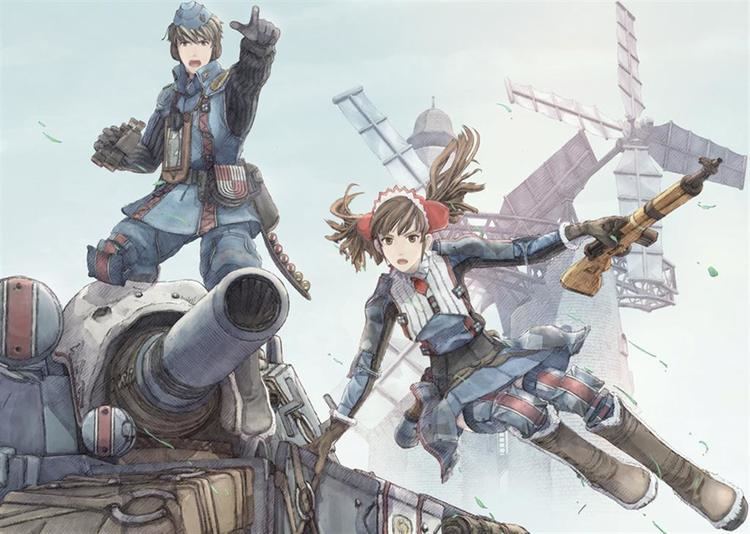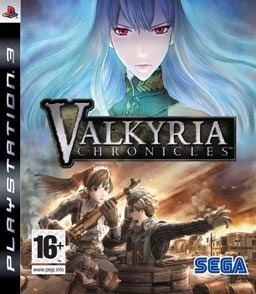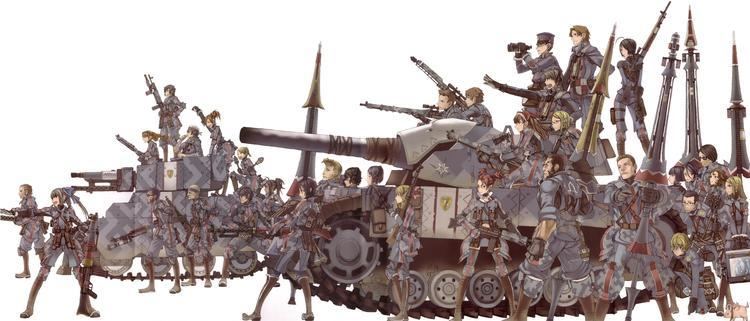8.4 /10 1 Votes8.4
7.8/10 MyAnimeList Designer(s) Takeshi Ozawa Series Valkyria Chronicles | 9/10 Steam 8.5/10 GameSpot Producer(s) Ryutaro Nonaka Engine CANVAS Engine | |||||||||||||||||||||||||||||||||
 | ||||||||||||||||||||||||||||||||||
Director(s) Shuntaro TanakaTakaharu Terada Release PlayStation 3JP: April 24, 2008UK: October 31, 2008NA: November 4, 2008Microsoft WindowsWW: November 11, 2014PlayStation 4Valkyria Chronicles RemasteredJP: February 10, 2016UK: May 17, 2016NA: May 17, 2016 Awards GameSpot Award for Best Graphics, Artistic Similar Valkyria Chronicles games, Sega games, Tactical role-playing games | ||||||||||||||||||||||||||||||||||
Valkyria chronicles gameplay sample
Valkyria Chronicles (Japanese: 戦場のヴァルキュリア -Gallian Chronicles-, Hepburn: Senjō no Varukyuria -Garian Kuronikuruzu-, "Valkyria of the Battlefield -Gallian Chronicles-") is a tactical role-playing game developed and published by Sega for the PlayStation 3 in 2008. A Microsoft Windows version was released in November 11, 2014. A remastered version for PlayStation 4 was released in Japan on February 10, 2016 with a Western release on May 17, 2016. Both PC and PS4 versions include previously released downloadable content.
Contents
- Valkyria chronicles gameplay sample
- Valkyria chronicles review
- Gameplay
- Plot
- Development
- Release
- Reception
- Sales
- Awards and nominations
- References

The game is set in Europa, a fictional region loosely based on Europe during the early years of World War II. Because of its abundance of Ragnite ore, which takes the place of petroleum in the game setting, the neutral nation of Gallia comes under attack from the East Europan Imperial Alliance, which is itself engaged in war with the Atlantic Federation. Players take control of a unit of the Gallian Militia, dedicated to repelling the invasion. The game's visuals, which use Sega's CANVAS graphics engine, resemble pencil drawn paintings in motion.

Valkyria Chronicles earned numerous awards from several notable video game publications. The success of the game spawned a media franchise, including several manga titles and an anime series. Two sequels were released for PlayStation Portable, Sony's handheld gaming console: Valkyria Chronicles II in 2010, and Valkyria Chronicles III in 2011. A fourth installment, Valkyria Revolution, is set to be released on January 19, 2017 for the PlayStation 4 and PlayStation Vita.

Valkyria chronicles review
Gameplay
Valkyria Chronicles is a tactical role-playing game in which the player uses a unique turn-based battle system called BLiTZ (Battle of Live Tactical Zones). During their turn the player views an overhead map in Command Mode, but zooms in to control each individual unit on the battlefield in Action Mode. Much like the Growlanser series, movement and other actions are handled in real time during Action Mode, though limited in movement by an action point (AP) gauge that varies for each type of character. During Target Mode, the player is in direct control of characters' aim while the action freezes, allowing for head shots and other maneuvers. Taking command of individual units during the player's phase costs Command Points, which can be used dynamically to grant movement to many different units or the same unit consecutively with diminishing AP reserve, depending on what the player wants to accomplish. By using their troops the player must fulfill various conditions depending on the mission in order to achieve victory, most often the capture of a major enemy encampment. Upon completing missions, the player is awarded money and experience with which to upgrade their materiel and character classes, respectively, and the game's story is advanced. Missions can be failed if the player's forces are wholly incapacitated or killed, the squad's main battle tank is destroyed, or the player's main base camp is captured by the enemy.
Each character in the game fulfills a specific role — for instance, Alicia is a mid-range rifle-toting scout, while Welkin is a tank commander. Other roles include Shocktroopers (assault infantry), "Lancers" specializing in anti-tank warfare, snipers, and engineers. These various units form a rock-paper-scissors dynamic of strength and weakness. The foot soldiers (Scout, Shocktrooper, and Sniper) are effective against slower anti-tank units, anti-tank units can quickly destroy tanks with a well-aimed shot, and tanks are generally devastating against infantry, whose anti-personnel weapons are unable to inflict any significant frontal damage. While each character within a class is basically similar in terms of weaponry and statistics, each individual has a distinguishing set of Potentials: special abilities or stat modifiers triggered by various psychological or environmental factors in battle.
The environment also factors heavily in combat. In an urban level, for example, snipers can be sent onto rooftops to eliminate unsuspecting enemies below. Tanks can knock down walls and other obstacles to open new paths. Buildings and other structures offer hard cover around which to maneuver. Foliage offers soft cover to reduce the chance of being spotted by the enemy and to confound their aim when seen. As the Gallian forces advance across the battlefield, control points can be captured, giving the player a tactical advantage and offering additional locations in which to call reinforcements. As Welkin, the player can issue various Orders for the purpose of things such as artillery strikes, supervising medics, and improving offensive or defensive capabilities of various characters.
Plot
In 1935 E.C., the continent of Europa is dominated by two superpowers: The Autocratic East Europan Imperial Alliance in the east and a commonwealth of loosely allied democracies known as the Atlantic Federation in the west. The economies of both powers depend on a precious multipurpose mineral called Ragnite. Its growing scarcity results in the Empire declaring war on the Federation, sparking the Second Europan War. The Empire uses its military superiority to quickly put the Federation on the defensive. Emboldened by their progress and momentum, the Empire decides to invade the neutral Principality of Gallia to seize its rich Ragnite deposits.
When Imperial forces launch an attack on the Gallian border town of Bruhl, Welkin Gunther, son of the country's hero General Belgen Gunther, is forced to fight for his life alongside the town watch captain, Alicia Melchiott. Together with Welkin's adopted sister Isara and using Belgen's prototype tank from the first war, the Edelweiss, they escape to the capital city of Randgriz and join the Gallian militia. Welkin is promoted to the rank of Lieutenant and assumes command of the newly formed Squad 7, with Alicia acting as his non-commissioned officer. Members of the squad initially question Welkin's qualifications due to a lack of combat experience. He quickly gains their trust and loyalty, however, with his brilliant tactics. Welkin and Alicia soon become romantically engaged, and Isara is killed by an imperial sniper.
After Squad 7 wages a successful campaign against Imperial forces, the crown prince Maximilian deploys one of his commanders, Selvaria Bles, a rare descendant of the Valkyrians who are believed to have saved the ancient world from the Darcsen race. Using innate magic powers and equipped with a legendary Ragnite lance and shield, Selvaria destroys the Gallian army. Alicia is shot by Welkin's archaeologist colleague Faldio Landzaat to awaken her own latent Valkyrian powers. Alicia is able to drive Selvaria back, allowing the Gallians to advance to the border. At the cost of her own life, Selvaria uses the "final flame" after the capture of the Ghirlandaio fortress, killing the entire core of Gallian military and leaving only the militia, such as Squad 7, remaining.
In an attempt to create his own empire, Maximilian uses a "land dreadnought", the Marmota, to break through Gallia's defenses and steal a giant Valkyrian lance from inside Randgriz Castle. The princess reveals herself to be Darcsen - the Valkyrians rewrote history to make themselves into heroes, while an allied Darcsen tribe gained Randgriz as the spoils. With Alicia's help, Squad 7 is able to board the Marmota and send Maximilian to his demise, destroying the dreadnought and ending the conflict between the two factions. Alicia and Welkin return to Bruhl, where they marry and raise a daughter named Isara together.
Development
The game's development team consisted mainly of staff that had been involved in the Sakura Wars series, led by producer Ryutaro Nonaka and director Shuntaro Tanaka. Together, they desired to create a game that combined facets of their previous works: strategy elements from the Sakura Wars series, third-person action elements from Nonaka's Nightshade, and role-playing influence from Tanaka's Skies of Arcadia. Originally under the working title Gallian Panzers, the team concentrated on making the strategic and action portions of the game of equal importance. Planning aspects of game play were emphasized through the Potential skill system that distinguishes individuals under the player's command, giving them affinities for certain environments, conditions, and each other. Contrasting the steady pacing of other turn-based strategy titles, the third-person portion of the BLiTZ system was to have an atmosphere of immediacy and tension, achieved in part by allowing enemy soldiers to actively defend themselves during the player's turn, and vice versa. Also important was the incorporation of battle scenarios and map designs that mimic situations from World War II era combat, such as storming beachheads, stalking through forests, or breaking through barricades in the streets of an enemy-occupied city. They had also watched various war films and series such as Band of Brothers, Saving Private Ryan and Combat!.
To complement the gameplay, distinctive, stylistic visuals were decided upon and carried out through the CANVAS graphics engine. Adding a touch of fantasy to the mix, the development team hoped to be able to garner attention from gamers who did not play games with similar settings but more realistic combat. The use of a warm color palette took emphasis away from the "grotesque, realistic nature of war itself," as Nonaka had stated, and focused instead on the characters and story. Tanaka added that, "we wanted to show that realism isn't the only thing you can do with 3D graphics." The character designs for the game were created by Raita Honjou, who, along with the rest of the development staff, aimed for a look that was described by 1UP.com's Jeremy Parish as "rustic." In early stages designs drew more directly on examples from World War II, however they proved to be too modern for what the team wanted to achieve. Thus, Raita aimed for a motif closer to that found in World War I, first creating Alicia and Welkin's concept illustrations and using them as a basis for the rest of the Gallian cast. World War II influence can still be seen in the designs of Imperial characters such as Gregor, whose uniform is heavily based on German officers' uniforms from that period. The end result of these efforts was described by Japanese director Mamoru Oshii as giving him "an impression similar to ... the Nausicaä manga," and Nonaka admits to aiming for the style found in World Masterpiece Theater.
The music of Valkyria Chronicles was composed by Hitoshi Sakimoto, who explained that the entire process of composing, recording and editing the game's tracks took a total of eight months. The game's "Main Theme" was initially composed in a variety of arrangements by Sakimoto, who then incorporated those arrangements into other pieces with contrasting tones. Like those in charge of the game's visuals, Sakimoto cited the game's story as its center and biggest inspiration for him, adding a "military colour" to the score after this consideration. Other important themes written into the score are the contrast between the game's two most prominent female characters, Alicia and Selvaria, and the relationship between Alicia and Welkin.
Release
On September 29, 2008, Sega of America held an exclusive Valkyria Chronicles Pre-Launch event at the Sony Metreon in San Francisco. Press and public were both invited, and Sega used a raffle to give away soundtracks, Japanese figurines of the characters, matted art posters signed by Nonaka, and an 80 GB PS3. Sega let the community send in questions before the event, and posted these to Nonaka in an interview during the event. Pictures and a follow-up of the event were posted on the Sega of America Blog.
Supplemental downloadable content pertaining to the game was made available for purchase via PlayStation Network. First is the inclusion of a Hard EX Mode, extra challenging versions of existing skirmish missions where the Edelweiss is unavailable. Two side story chapters, "Edy’s Mission: Enter the Edy Detachment" and "Selvaria's Mission: Behind Her Blue Flame," introduce Squad 7's motliest crew led by Edy Nelson and Homer Pieron, and the early portion of the invasion into Gallia as seen from the Imperial perspective. Hard EX Mode and Edy's Mission were originally released for the Japanese version on August 8, 2008, while Selvaria's Mission was released on October 31 of the same year. All three were made available in North America on April 16, 2009. A fourth DLC, titled "Edy Detachment's Formal Challenge!" was made available in Japan on June 26, 2009, and in North America on February 25, 2010. Included are a set of six challenge missions, each focusing on one of the game's unit classes. The addition of Trophy support has yet to occur, however, there has been some indication of possible support in the future.
Valkyria Chronicles was re-released in Japanese retails stores under its The Best label on March 5, 2009 with a retail price of ¥3,900. This version of the game includes Edy's Mission without need of download.
Valkyria Chronicles was ported to Windows and released on Steam on November 11, 2014 with a retail price of 20 USD. This version of the game includes all downloadable content. The PC release features performance improvements, including the ability to play the game at 60 frames per second and on resolutions greater than 1080p, in addition to customised control mapping.
A remastered version, titled Valkyria Chronicles Remastered, was announced by Sega and released on May 17, 2016 for PlayStation 4 in North America and Europe. The remastered console version runs at 1080p and 60 frames per second and includes both Japanese and English audio as well as all downloadable content. Outlet Crash Landed praised the remastered versions visuals and still stellar gameplay in their review, but criticized the lack of PlayStation 4 functionality implemented.
Reception
Valkyria Chronicles has been received highly positively by numerous sources, including writers for IGN, RPGFan, G4TV's X-Play, GameTrailers. Kevin VanOrd of GameSpot was impressed with the title's gameplay design, noting that it gave players a new sense of tactical freedom absent in other games of the same genre via the removal of certain staples such as a grid-based map. Some reviewers enjoyed the active and strategic nature of combat. According to Game Revolution's Chris Hudak, "nail-gnawingly tense" situations kept the player emotionally involved in the game. Both the game's story and the way in which it was presented were cited as strong points. Longevity was also attributed to the game, with James Quentin Clark of RPGFan noting that, "the game gets better the more you play it." While pleased overall, multiple reviewers criticized the artificial intelligence of enemy forces. Others stated that the third-person camera interfered with the ability to shoot effectively in certain situations.
Sales
Despite receiving positive press, sales of the game have been mixed. While it sold 77,000 copies in its first week of release in Japan and a further 81,000 during its budget release, the game only sold 33,000 copies in the United States during November 2008. The game failed to reach the top 100 sold software in the month of November., it was the 93rd best-selling game in Japan in 2008, selling 141,589 copies. Despite weak initial North American sales, Valkyria Chronicles recovered with sales sharply increasing in April 2009 following a price cut and the simultaneous release of an anime based on the game. Approximately a year after the game's initial release, both producer Ryutaro Nonaka and gamers surveyed by Famitsu stated interest in a sequel to the game.
The 2014 PC version of the game exceeded its publisher's expectations, topping the Steam sales charts on the day of its release, ahead of the then also recently launched games Call of Duty: Advanced Warfare and Assassin's Creed Unity. It also received favorable reviews, with a Metacritic score of 85.
As of January 2017, the PC version of the game has sold about 900,000 copies on Steam.
Awards and nominations
Valkyria Chronicles won "Best Artistic Graphics" from GameSpot. The game's soundtrack was awarded the "Best Original Soundtrack" by GameSpy, and Strategy Game of the Year 2008. GameTrailers nominated it for the "Best Role-Playing Game" category. Gaming Target recognized the game in the "40 Games We'll Still Be Playing From 2008" category. IGN recognized the game as "PlayStation 3 Strategy Game of 2008. RPGFan awarded the game with the "PlayStation 3 RPG of the Year" and "Best Strategy RPG on a Console" awards. and several RPGamer awards including the "RPG of the Year", "Best Graphics", and "PlayStation 3 RPG of the Year" categories. On June 17, 2010, Valkyria Chronicles was recognized by Guinness World Records as the best strategy RPG on the PlayStation 3.
